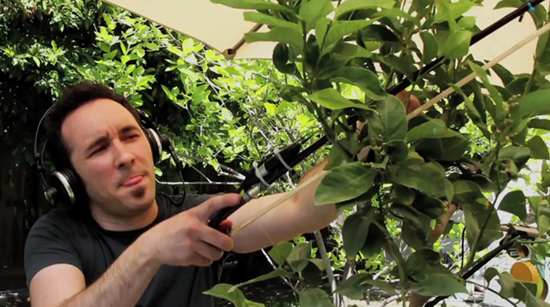
While we may have different preferences, music is something we all love. It can break the language barrier and allow us to communicate something truly universal. But it also transcends language in that it can convey emotions that words can never truly be strong enough to express. The world of music is massive, and these are 10 of the strangest stories from it.
10. Brown Note
The brown note is an alleged musical note that will magically cause people to defecate involuntarily. This myth just doesn’t want to die, and many people still think that it’s possible. As governments continue to work on crowd control weapons, especially those that use sonic frequencies, some people have speculated that the government is working on a practical brown note apparatus.
Despite the persistent rumours, there’s no sonic machine that’s capable of making people void their bowels against their will - although it is true that governments have experimented with sonic weapons for crowd control. Some people are still sceptical and believe that perhaps the powers that be are hiding these machines from us. For those that want more evidence, Mythbusters spent an episode on it. Not only could they not produce the sound, but an expert said that there’s no reason to believe such a thing is even possible in the first place.
9. The Singing Ringing Tree
This entry isn’t a real musical tree, but a sculpture located in Burnley in the United Kingdom that combines form and function to create something beautiful. The project cost 70,000 pounds and is nestled comfortably on the top of a hill that gets a lot of wind. The “tree” is made using large metal pipes of various lengths and diameters that work their way up in a pattern. The sculpture doesn’t look particularly beautiful from up close, but from a distance it adds a mystique to the landscape. You never know where the winds will shift, so the music will always be different. The winds flow through the different pipes and make strange sounds, sometimes discordant and sometimes not. It has of course become a fairly popular attraction in the area, but for those of you who can’t make a trip to Burnley, there’s a video. It has a haunting, ethereal quality that can change at random, just like the shifting and capricious winds it’s interpreting.
8. The Beatles Couldn’t Read Music
The Beatles’ contribution to music simply can’t be overestimated. Even if you don’t care for them, a great many artists you probably like were influenced by the Beatles in some way. Yet despite being geniuses who revolutionized music, they couldn’t read traditional sheet music. When writing the song “Golden Slumbers,” Paul McCartney had found the words in a children’s songbook, but he couldn’t read music so he wrote his own melody for it in his own style. This isn’t particularly unusual, as knowing how to read and write music the traditional way is not something someone with natural musical talent will know from birth - it’s a notational skill. While it may seem odd that the biggest musical act of their generation couldn’t read music, in the end it hardly matters, and that’s the real point. If you really love something and you have a knack for it, don’t let anything keep you from doing it, regardless of any skills you may currently lack.
7. The Replica Holophonor
In a popular Futurama episode Fry tries to woo Leela by learning to play an incredibly difficult instrument known as a holophonor. It turns out that human hands are terrible for playing the extremely complex instrument and so Fry makes a deal with the robot devil to get his hands instead. The robot devil, being a devil, doesn’t play fair and starts going to elaborate depths of trickery to get his hands back. Eventually Fry has to sacrifice his ability to play the holophonor in order to help Leela.
A prop designer in Atlanta named Harrison Krix had a client express interest in a replica of the holophonor, so he set about making one of the most detailed replicas of anything you will ever see. He started with a dirty second hand clarinet that he had to clean unspeakable things out of, spent hours in a workshop hooking up LED lights and even crafted a pair of robot hands on a handsome stand to hold the instrument. It doesn’t play music, but it’s a stunning work of art. For those who are interested in how he made it, he has an entire guide available on his website. Perhaps one day we’ll have real holophonors we can play. We can dream, right?
6. Music And Plant Growth
The question of whether music affects the growth of plants has been debated for a long time. Most of the experiments that claim music affects plant growth fail at basic rigor - there are far too many variables to control for that aren’t being taken into account. And it’s almost impossible to truly have proper controls for an experiment. Even if your control plant isn’t listening to music, it’s still likely to be hearing ambient sounds. So for a proper experiment you’d need to find a room for your control plant that’s literally devoid of sound, such as an anechoic chamber.
The only way music could be affecting a plant is if the sound made minute changes in air pressure. However, there’s no reason to believe that music causing such minute affects on the air around it could negatively or positively affect the growth of a plant. Some people have suggested that playing music for your plants is more for the person growing them, as it puts them in a better mood, and thus they take better care of their vegetation.
5. The Riverside Carillon
The carillon is a rare and little known instrument. It requires a very large space, such as a church, to accommodate it. It contains numerous bells which the operator can play from one position using a series of pedals and levers. This instrument has always remained somewhat niche, with the organ or piano being favoured in most churches, but that hasn’t kept it from making its mark. The Riverside Carillon resides in the Riverside Church in New York and was a present from the Rockefeller family. It’s the largest carillon in the world and weighs over 100 tons, which easily makes it one of the biggest musical instruments to ever exist.
The Church has become worried about the safety of their treasure, so they won’t allow people near the mechanisms or tours of the instrument itself. However, they play it regularly throughout the week and people are always welcome to stop by the nearby parks and listen to the beautiful music. Their website offers an audio sample and gives detailed times and dates for when people can stop by the area and enjoy the largest carillon in the world.
4. Shattering Glass With Your Voice
It’s long been a trope in fiction that an opera singer or anyone else with an extremely high voice can belt out a loud and sustained note to break a glass. Over time the belief has extended to the ability to break not only a wine glass, but windows, chandeliers…anything, really. While this has long been spread as an anecdote, there’s been precious little evidence of the phenomenon being real.
Many people have tested this on wine glasses and not had much success, although people have found it easy to do if they use an amplifier. So the theory is sound - the real question is whether a human would be able to do it naturally. Again we consult the Mythbusters, who tried to shatter several different wine glasses with a voice and succeeded on only one out of twelve. They proved that it’s possible for a human voice to shatter glass without any amplification, but it’s likely only to work on glassware that already had flaws or imperfections.
3. The Badgermin
It’s a badger! It’s a theremin! It’s a…Badgermin? Okay, we’re confused and more than a little creeped out. You may not be familiar with a theremin - it uses antennas and electrical signals to make music without you actually touching anything, and makes the person playing it look like a wizard. Because of its strange nature and the fact that it’s a fairly recent instrument, there aren’t many expert players in the world. But that didn’t stop someone from deciding that it would be incredible fun to make a theremin out of a dead badger.
Some people may consider this to be grotesque or cruel to animals, but you can’t deny that the gimmick certainly got people’s attention. The creator of this absurd theremin stuffed badger (or badger stuffed theremin, if you prefer) had one of the best theremists around play it for him as a sort of joke and put the video up on his site. Unfortunately, so many people wanted to watch just so they could see a badger being played as a musical instrument that it became the first search result for his name. Feeling this wasn’t good for his reputation, the artist asked for the video to be removed.
2. Music From A Tree
Diego Stocco felt that the natural musical abilities of a tree were being wasted. He used a stethoscope, a pencil sharpener and a tree in his backyard and created a unique musical piece. The natural cosmetics company Burt’s Bee’s was interested in him after they watched his video and asked him to make them something for Earth Day. He came up with a new piece called “Music From Nature,” which used not only a tree but a variety of natural sounds, including orange peels, coconuts, honey and even real live bees.
No words can possibly do justice to his unique sounds. Fortunately they’re all available on YouTube, including strange pieces like “Music From A Dry Cleaner,” a strangely catchy tune that captures your imagination. Stocco is quoted as saying, “I know it’s funny, but that’s the whole idea, you can really make music with everything!”
1. Concert In A Cave
In Houston, Texas there’s a fantastic cave known as the Cave Without A Name, possibly because the site was used by bootleggers during prohibition. Now, however, it serves an entirely different purpose. The cave was found to have a large domed room deep within that had absolutely amazing acoustics. Small sounds come back greatly amplified and many musical performers prize the cave because they feel that it’s an almost spiritual experience to play there. While it may sound a little over the top, those who listen to a concert in the cave tend to find it an amazing experience. The performers often play in complete blackness, completely cut off by outside noises with perfect acoustics. Under such amazing conditions it would be difficult to avoid being swept up by the musical experience.
While this is a fairly new attraction, researchers studying cave drawings have speculated that using caves for their acoustic properties is actually a very ancient practice. These researchers have noticed that the drawings they found were usually in the same area, even when there was plenty of other space to draw. Finding this unusual, they discovered that these clusters of drawings were usually in parts of the cave that would be acoustically ideal for any kind of singing or chanting. This would suggest that prehistoric man used the drawings, music and acoustic properties of the caves all at once, possibly for entertainment or to pass on the oral history of their people.










No comments:
Post a Comment
Please adhere to proper blog etiquette when posting your comments. This blog owner will exercise his absolution discretion in allowing or rejecting any comments that are deemed seditious, defamatory, libelous, racist, vulgar, insulting, and other remarks that exhibit similar characteristics. If you insist on using anonymous comments, please write your name or other IDs at the end of your message.